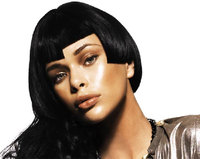Ethnic beauty: Make up or make do?
 Latest research from Mintel finds that black and Asian consumers are not being adequately catered for by the beauty industry. Although the UK's market for ethnic cosmetics and toiletries has grown by some 24% since 2002, it is still only worth £65 million - less than 2% of the total £3.7 billion UK beauty market.
Latest research from Mintel finds that black and Asian consumers are not being adequately catered for by the beauty industry. Although the UK's market for ethnic cosmetics and toiletries has grown by some 24% since 2002, it is still only worth £65 million - less than 2% of the total £3.7 billion UK beauty market. Considering that over the last five years, the ethnic community* has grown rapidly, and one in every ten adults in the UK is now of ethnic origin (according to ONS figures), it would seem that the beauty industry is failing to meet the needs of modern day Britain.
"A lack of new product development on the part of manufacturers as well as limited availability, has undoubtedly been a major barrier in the ethnic beauty market," comments Alexandra Richmond, senior consumer analyst at Mintel.
"Today there is clearly a demand for products specifically designed for the growing number of ethnic consumers. Although there are luxury beauty ranges for those with darker skin tones, mass market alternatives on the high street are still few and far between."
Face of the future
Looking to the future, Mintel believes that a little investment could turn the ethnic cosmetics and toiletries market into one of the beauty industry's most promising sectors. Indeed, Mintel forecasts that with the right investment in new products and advertising this market could grow by as much as 35% in the next five years alone, to reach £88 million by 2012.
"In today's mainstream market we are seeing ever more products targeting very specific beauty needs, from anti-ageing creams for different age groups to shampoos for any number of hair types. There is clearly the potential for the industry to apply this approach to the ethnic beauty market, which would undoubtedly be welcomed by ethnic consumers and give the market a much needed boost," comments Alexandra.
(Not) all wrapped up!
The market could also benefit from updating its current approach to advertising and packaging. The industry spent just £150,000 on advertising last year. Meanwhile in 2005 adspend in the UK on make up alone was worth an incredible £45 million - clearly the ethnic market is under-represented.
Packaging too has not kept up with the modern day beauty market. Many US ethnic brands were launched in the UK in the 1980s, and have barely changed their appearance since. At the time, the American look was very appealing, with an emphasis on white teeth and big hair. However, this is now widely out of kilter with today’s young black and Asian women.
"Rebranding and repackaging could help ethnic brands compete with mainstream products not just in terms of winning the ethnic pound, but also by enhancing product credibility," explains Alexandra.
* Black, Black British, Asian, Asian British, Mixed race

